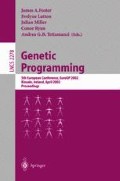Abstract
We present a study that analyses the respective advantages and disadvantages of the synchronous and asynchronous versions of island-based genetic programming and also a relationship between the number of subpopulations in parallel GP and the asynchronous model. We also look at a new measuring system for comparing parallel genetic programming with panmictic model. At the same time we show an interesting relationship between the bloat phenomenon and the number of individuals we use.
Access this chapter
Tax calculation will be finalised at checkout
Purchases are for personal use only
Preview
Unable to display preview. Download preview PDF.
References
D. Andre and J R. Koza. “Parallel Genetic Programming: A Scalable Implementation Using The Transputer Network Architecture”. P. Angeline and K. Kinear editors. Advances in Genetic Programming 2, Cambridge, MA, 1996.
E. Cantú-Paz and D. Goldberg: “Predicting Speedups of Ideal Bounding Cases of Parallel Genetic Algorithms”. Proceedings of the Seventh International Conference on Genetic Algorithms. Morgan Kaufmann. 1997.
A. Tetamanzi, M. Tomassini,“Soft Computing”. Springer Verlag, Heideberg, Germany 2001
W.F. Punch: “How effective are multiple populations in Genetic Programming”. Genetic Programming 1998: Proceedings of the Third Annual Conference, J. R. Koza, W. Banzhaf, K. Chellapilla, K. Deb, M. Dorigo, D. B. Fogel, M. Garzon, D. Goldberg, H. Iba and R. L. Riolo (Eds),Morgan Kaufmann, San Francisco, CA, pp. 308–313, 1998.
M. Tomassini, F. Fernández, L. Vanneschi, L. Bucher, “An MPI-Based Tool for Distributed Genetic Programming” In Proceedings of IEEE International Conference on Cluster Computing CLUSTER2000, IEEE Computer Society. pp.209–216. 2000.
F. Fernández, M. Tomassini, L Vanneschi, L. Bucher, “The GP’s Tool”. http://www-iis.unil.ch/gpi/tool.html
J. R. Koza, F. H. Bennett III, D. Andre, M.A. Keane: “Genetic Programming III. Darwinian Invention and Problem Solving”. Morgan Kaufmann Publishers. San Francisco. 1999.
Ricardo Poli: “Evolution of graph-like programs with parallel distributed genetic programming”. In proceedings of the 7th International Conference on Genetic Algorithms, T. Bäck (ed.), Morgan Kaufmann, San Francisco, CA, 1997, pp. 346–353.
F. Fernández, “Parallel and Distributed Genetic Programming models, with application to logic syntesis on FPGAs”, PhD Thesis. Universidad de Extremadura, February 2001.
F. Fernández, M. Tomassini, L. Vanneschi: “Studying the influence of Communication Topology and Migration on Distributed Genetic Programming”, In J. Miler, M. Tomassini, P.L. Lanzi, C. Ryan, A. G.B. Tettamanzi, W. Landdon, LNCS 2038 Genetic Programming, 4th European Conference, EuroGP 2001. Pp 51.63
Enrique Alba, José M. Troya: “Analyzing synchronous and asynchronous parallel distributed genetic algorithms”. Future Generation Computer Systems 17 (2001) 451–465
W. Langdon and R. Poli. “Fitness causes bloat”. In P.K. Chawdhry et. al., editors. Soft Computing in Engineering Design and Manufacturing, pp 13–22. Springer London, 1997.
J. R. Koza: “Genetic Programming. On the programming of computers by means of natural selection”. Cambridge MA: The MIT Press. 1992.
MPI Forum (1995) MPI: A Message-Passing Interface Standard. http://www.mpi-forum.org/index.htm.
Author information
Authors and Affiliations
Editor information
Editors and Affiliations
Rights and permissions
Copyright information
© 2002 Springer-Verlag Berlin Heidelberg
About this paper
Cite this paper
Fernández, F., Galeano, G., Gómez, J. (2002). Comparing Synchronous and Asynchronous Parallel and Distributed Genetic Programming Models. In: Foster, J.A., Lutton, E., Miller, J., Ryan, C., Tettamanzi, A. (eds) Genetic Programming. EuroGP 2002. Lecture Notes in Computer Science, vol 2278. Springer, Berlin, Heidelberg. https://doi.org/10.1007/3-540-45984-7_32
Download citation
DOI: https://doi.org/10.1007/3-540-45984-7_32
Published:
Publisher Name: Springer, Berlin, Heidelberg
Print ISBN: 978-3-540-43378-1
Online ISBN: 978-3-540-45984-2
eBook Packages: Springer Book Archive

